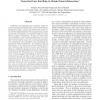13 search results - page 1 / 3 » How important is location information in saliency detection ... |
NIPS
2007
13 years 6 months ago
2007
Under natural viewing conditions, human observers shift their gaze to allocate processing resources to subsets of the visual input. Many computational models try to predict such v...
ICRA
2010
IEEE
13 years 3 months ago
2010
IEEE
— This paper presents a saliency-based solution to boost trail detection. The proposed model builds on the empirical observation that trails are usually conspicuous structures in...
ETRA
2008
ACM
13 years 6 months ago
2008
ACM
Under natural viewing conditions, human observers use shifts in gaze to allocate processing resources to subsets of the visual input. There are many computational models that try ...
FGR
2008
IEEE
13 years 11 months ago
2008
IEEE
Unobtrusive and multiple-sensor interfaces enable observation of natural human behavior in smart environments. Being able to detect, analyze and interpret this activity allows for...
ICASSP
2011
IEEE
12 years 8 months ago
2011
IEEE
Selective attention in the human visual system is performed as the way that humans focus on the most important parts when observing a visual scene. Many bottom-up computational mo...

